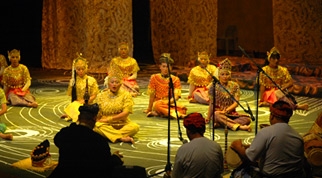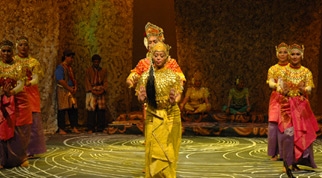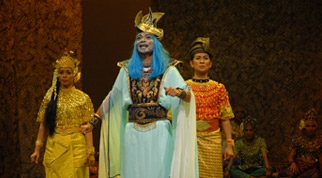
Makyung is a form of Malay traditional dance theatre combining acting, dance, singing, drama, romance and comedy in a single presentation. This form of dance theatre is believed to be originated from the old Malay Kingdom - stretching from the Patani region of southern Thailand through Kelantan, a north eastern state of West Malaysia. The art of Makyung performance is handed down through the generations, whose teaching were memorised by a handful of actors, musicians and comedians. One of the unique features of this dance theatre is that the main characters are all women, and the men play the peripheral characters to add humour and side relief to its intricate web of multiple plots.
Most roles are performed by women. The performing troupe usually has four leading actresses who play the parts of the King, the Hero, the Queen and the Heroine. Female actors played the roles of the court attendants or even the roles of prince as well as princesses. The men were usually given the parts as of the comedians, ogres or demons. Two of these men would play lead comedians, while the others would act in a supporting roles.
A typical Makyung performance opens with an offering followed by dances, acting and music as well as improvised monologues and dialogues. A single story can be presented over several consecutive nights in a series of three-hour performances. In the traditional village setting, the performances are held on a temporary open stage build of wood and palm leaves. The audience sits on three sides of the stage, the fourth side being reserved for the orchestra consisting of the Rebab (a three-stringed spiked fiddle), a pair of Gendang (double-headed barrel drums) and Tetawak (a pair of hanging knobbed gongs). The stories in Makyung are based on ancient Malay folk tales consist of royal characters, divinities and clowns. Makyung is also associated with rituals in which shamans attempt to heal through song, trance-dance and spirit possession.
A favourite form of entertainment in the palace courtyard of Kelantan and Patani, Makyung was often performed for members of the Royal family and aristocrats. However, it wasn’t until the beginning of the 19th century that the court performance of Makyung was made available to the public as well. Malaysian Makyung is arguably different from its counterparts in Indonesia, Thailand and old Cambodia in term of its stories, music, dances as well as the costumes used. Makyung was recently acknowledged as a "Masterpiece of the Oral and Intangible Heritage of Humanity" by UNESCO in 25 November 2005.
This website provides a visual presentation to capitalize on sustaining and conserving Makyung as a constituent part of affirming and enriching Malaysia’s cultural identity. These heritage forms are an irreplaceable source of spiritual and intellectual output that requires intensive efforts in stimulating and rekindling appreciation both locally and internationally.


